University IoT Report: Security Issues, Solutions, and Future Trends
VerifiedAdded on 2020/03/28
|11
|2928
|364
Report
AI Summary
This report delves into the security challenges and potential solutions within the rapidly expanding field of the Internet of Things (IoT). It begins by defining IoT and its significance, highlighting its benefits such as improved customer engagement, technological optimization, waste reduction, and enhanced data collection. The report then addresses the critical security concerns associated with IoT, including the need for trust, the technical constraints of device manufacturing, and the increased attack surface due to the proliferation of interconnected devices. It explores various IoT applications like wearables, industrial internet, smart cities, and healthcare, emphasizing the importance of robust security measures at every level. The report discusses the impact of cyber security, social and cultural considerations, and the role of IPv6 in the development and implementation of IoT, concluding with the necessity of prioritizing security and privacy to ensure the continued growth and trustworthiness of IoT technologies. The report also touches upon the need for standardization and interoperability in the IoT ecosystem.
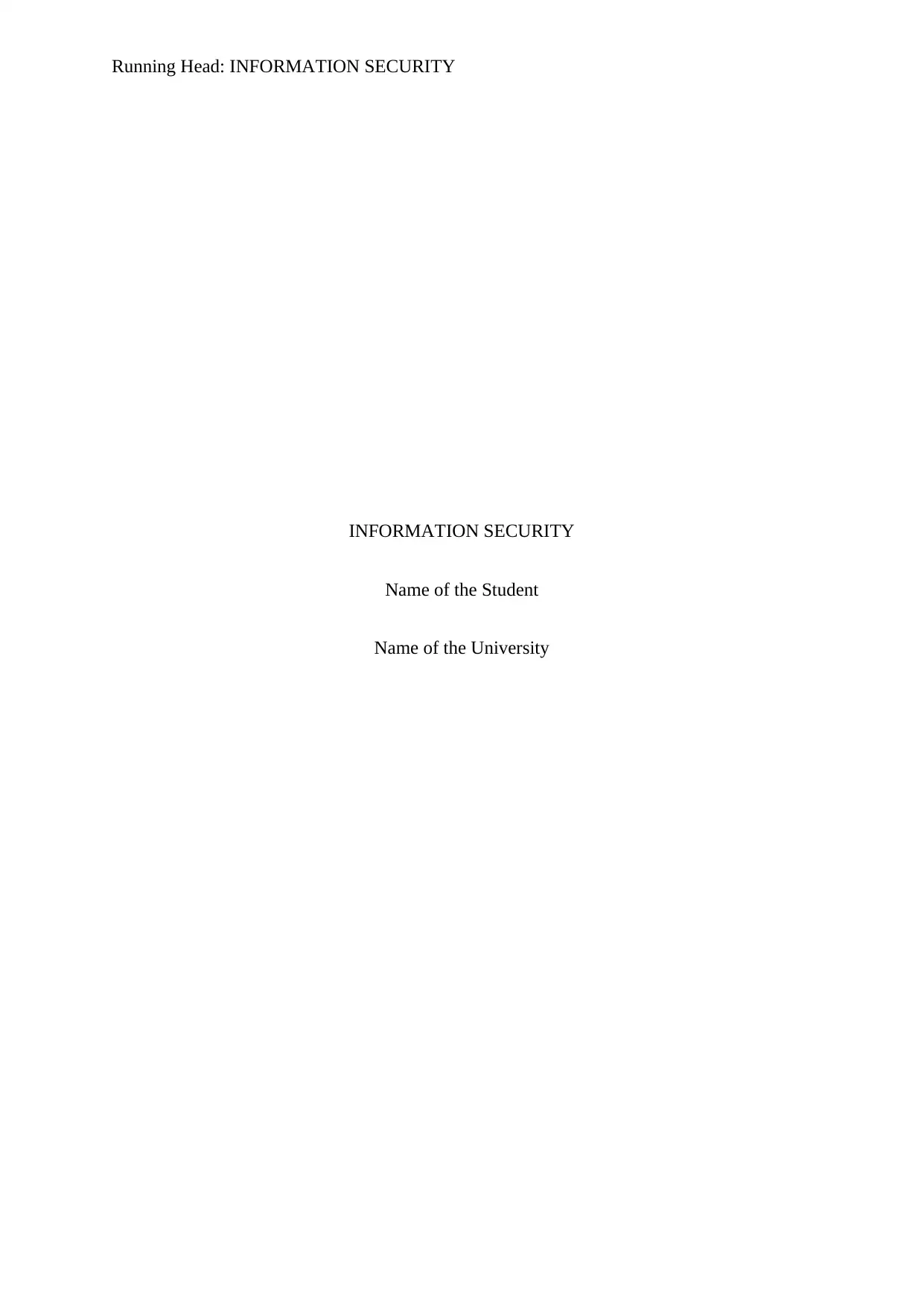
Running Head: INFORMATION SECURITY
INFORMATION SECURITY
Name of the Student
Name of the University
INFORMATION SECURITY
Name of the Student
Name of the University
Paraphrase This Document
Need a fresh take? Get an instant paraphrase of this document with our AI Paraphraser
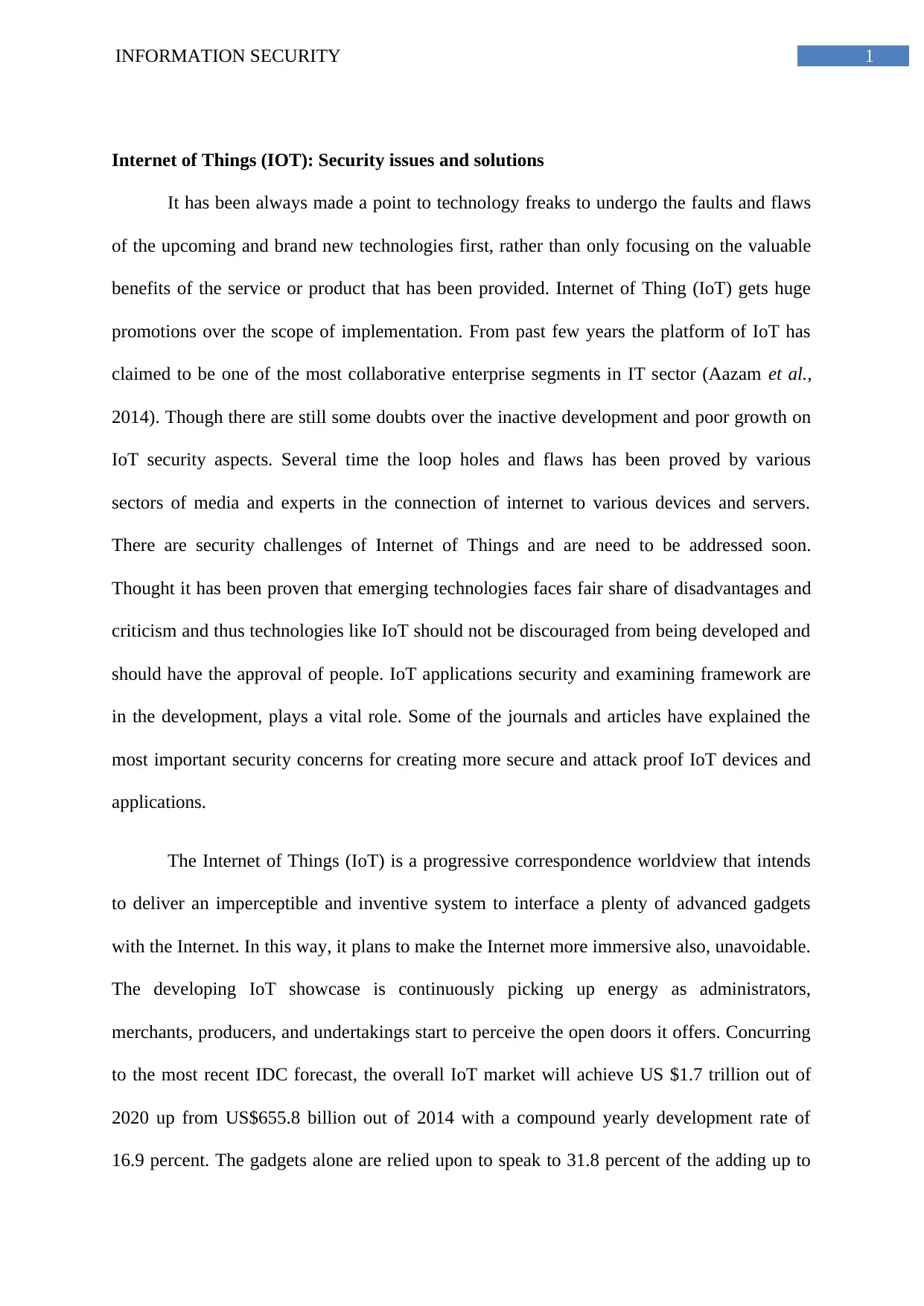
1INFORMATION SECURITY
Internet of Things (IOT): Security issues and solutions
It has been always made a point to technology freaks to undergo the faults and flaws
of the upcoming and brand new technologies first, rather than only focusing on the valuable
benefits of the service or product that has been provided. Internet of Thing (IoT) gets huge
promotions over the scope of implementation. From past few years the platform of IoT has
claimed to be one of the most collaborative enterprise segments in IT sector (Aazam et al.,
2014). Though there are still some doubts over the inactive development and poor growth on
IoT security aspects. Several time the loop holes and flaws has been proved by various
sectors of media and experts in the connection of internet to various devices and servers.
There are security challenges of Internet of Things and are need to be addressed soon.
Thought it has been proven that emerging technologies faces fair share of disadvantages and
criticism and thus technologies like IoT should not be discouraged from being developed and
should have the approval of people. IoT applications security and examining framework are
in the development, plays a vital role. Some of the journals and articles have explained the
most important security concerns for creating more secure and attack proof IoT devices and
applications.
The Internet of Things (IoT) is a progressive correspondence worldview that intends
to deliver an imperceptible and inventive system to interface a plenty of advanced gadgets
with the Internet. In this way, it plans to make the Internet more immersive also, unavoidable.
The developing IoT showcase is continuously picking up energy as administrators,
merchants, producers, and undertakings start to perceive the open doors it offers. Concurring
to the most recent IDC forecast, the overall IoT market will achieve US $1.7 trillion out of
2020 up from US$655.8 billion out of 2014 with a compound yearly development rate of
16.9 percent. The gadgets alone are relied upon to speak to 31.8 percent of the adding up to
Internet of Things (IOT): Security issues and solutions
It has been always made a point to technology freaks to undergo the faults and flaws
of the upcoming and brand new technologies first, rather than only focusing on the valuable
benefits of the service or product that has been provided. Internet of Thing (IoT) gets huge
promotions over the scope of implementation. From past few years the platform of IoT has
claimed to be one of the most collaborative enterprise segments in IT sector (Aazam et al.,
2014). Though there are still some doubts over the inactive development and poor growth on
IoT security aspects. Several time the loop holes and flaws has been proved by various
sectors of media and experts in the connection of internet to various devices and servers.
There are security challenges of Internet of Things and are need to be addressed soon.
Thought it has been proven that emerging technologies faces fair share of disadvantages and
criticism and thus technologies like IoT should not be discouraged from being developed and
should have the approval of people. IoT applications security and examining framework are
in the development, plays a vital role. Some of the journals and articles have explained the
most important security concerns for creating more secure and attack proof IoT devices and
applications.
The Internet of Things (IoT) is a progressive correspondence worldview that intends
to deliver an imperceptible and inventive system to interface a plenty of advanced gadgets
with the Internet. In this way, it plans to make the Internet more immersive also, unavoidable.
The developing IoT showcase is continuously picking up energy as administrators,
merchants, producers, and undertakings start to perceive the open doors it offers. Concurring
to the most recent IDC forecast, the overall IoT market will achieve US $1.7 trillion out of
2020 up from US$655.8 billion out of 2014 with a compound yearly development rate of
16.9 percent. The gadgets alone are relied upon to speak to 31.8 percent of the adding up to
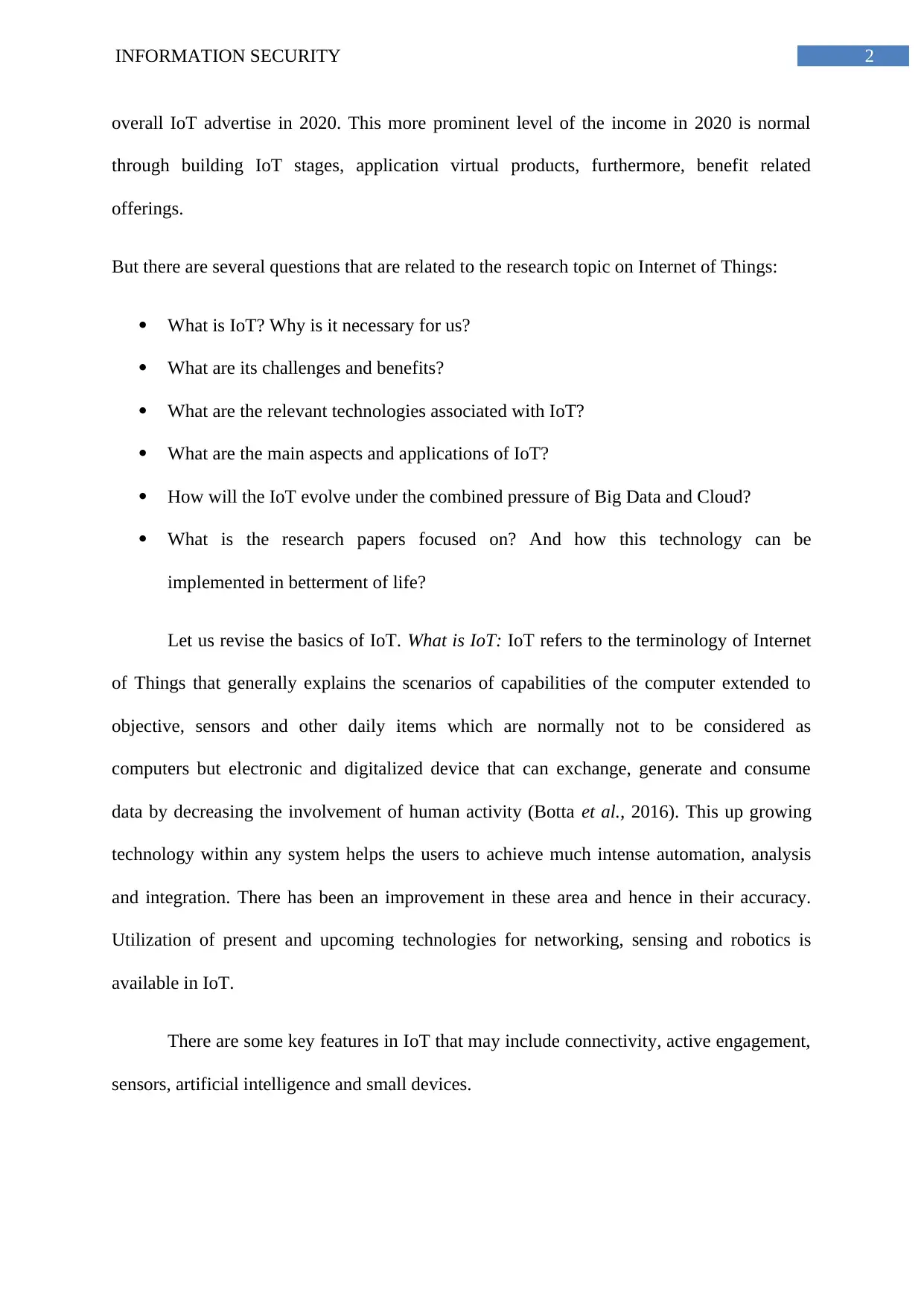
2INFORMATION SECURITY
overall IoT advertise in 2020. This more prominent level of the income in 2020 is normal
through building IoT stages, application virtual products, furthermore, benefit related
offerings.
But there are several questions that are related to the research topic on Internet of Things:
What is IoT? Why is it necessary for us?
What are its challenges and benefits?
What are the relevant technologies associated with IoT?
What are the main aspects and applications of IoT?
How will the IoT evolve under the combined pressure of Big Data and Cloud?
What is the research papers focused on? And how this technology can be
implemented in betterment of life?
Let us revise the basics of IoT. What is IoT: IoT refers to the terminology of Internet
of Things that generally explains the scenarios of capabilities of the computer extended to
objective, sensors and other daily items which are normally not to be considered as
computers but electronic and digitalized device that can exchange, generate and consume
data by decreasing the involvement of human activity (Botta et al., 2016). This up growing
technology within any system helps the users to achieve much intense automation, analysis
and integration. There has been an improvement in these area and hence in their accuracy.
Utilization of present and upcoming technologies for networking, sensing and robotics is
available in IoT.
There are some key features in IoT that may include connectivity, active engagement,
sensors, artificial intelligence and small devices.
overall IoT advertise in 2020. This more prominent level of the income in 2020 is normal
through building IoT stages, application virtual products, furthermore, benefit related
offerings.
But there are several questions that are related to the research topic on Internet of Things:
What is IoT? Why is it necessary for us?
What are its challenges and benefits?
What are the relevant technologies associated with IoT?
What are the main aspects and applications of IoT?
How will the IoT evolve under the combined pressure of Big Data and Cloud?
What is the research papers focused on? And how this technology can be
implemented in betterment of life?
Let us revise the basics of IoT. What is IoT: IoT refers to the terminology of Internet
of Things that generally explains the scenarios of capabilities of the computer extended to
objective, sensors and other daily items which are normally not to be considered as
computers but electronic and digitalized device that can exchange, generate and consume
data by decreasing the involvement of human activity (Botta et al., 2016). This up growing
technology within any system helps the users to achieve much intense automation, analysis
and integration. There has been an improvement in these area and hence in their accuracy.
Utilization of present and upcoming technologies for networking, sensing and robotics is
available in IoT.
There are some key features in IoT that may include connectivity, active engagement,
sensors, artificial intelligence and small devices.
⊘ This is a preview!⊘
Do you want full access?
Subscribe today to unlock all pages.

Trusted by 1+ million students worldwide
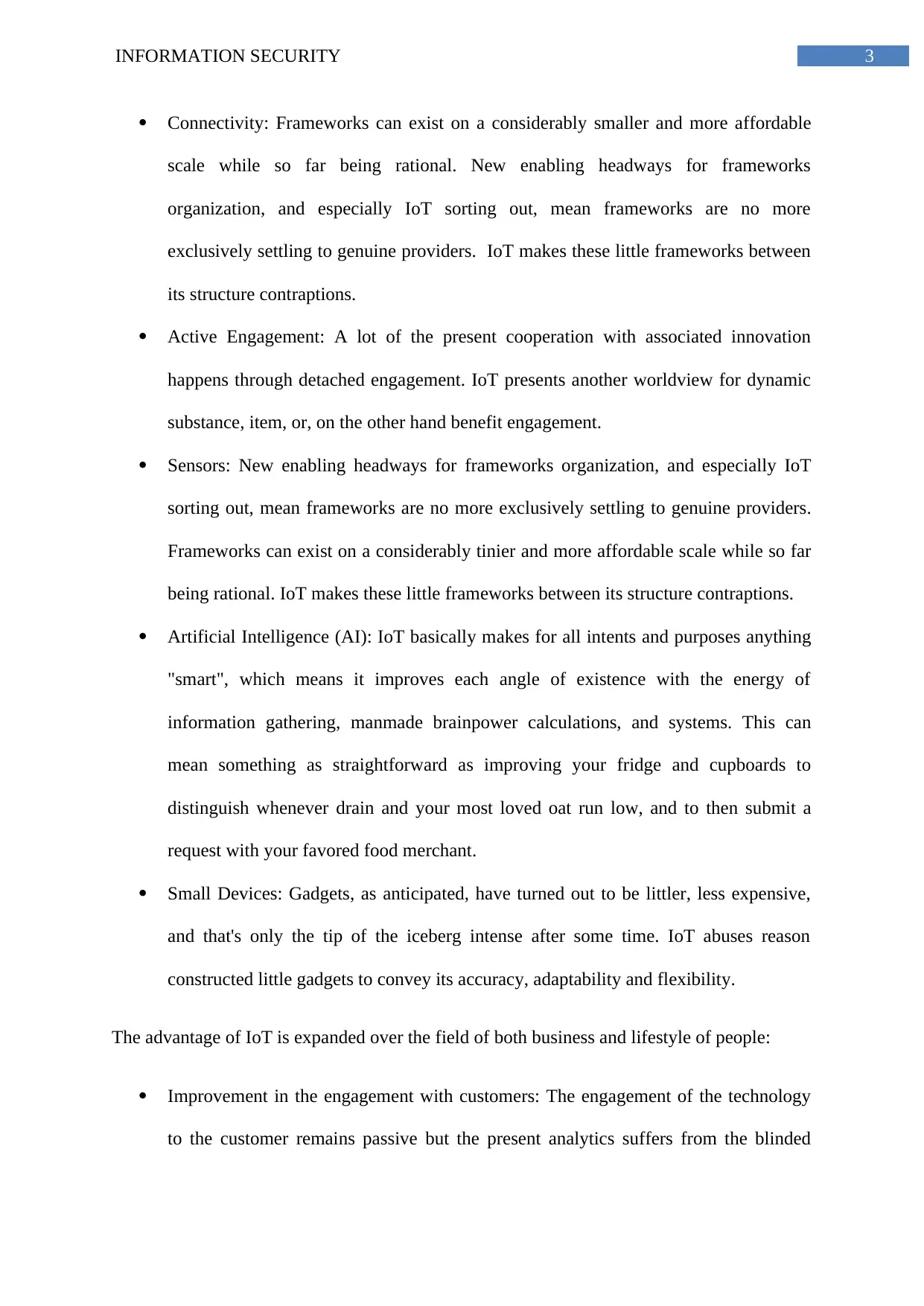
3INFORMATION SECURITY
Connectivity: Frameworks can exist on a considerably smaller and more affordable
scale while so far being rational. New enabling headways for frameworks
organization, and especially IoT sorting out, mean frameworks are no more
exclusively settling to genuine providers. IoT makes these little frameworks between
its structure contraptions.
Active Engagement: A lot of the present cooperation with associated innovation
happens through detached engagement. IoT presents another worldview for dynamic
substance, item, or, on the other hand benefit engagement.
Sensors: New enabling headways for frameworks organization, and especially IoT
sorting out, mean frameworks are no more exclusively settling to genuine providers.
Frameworks can exist on a considerably tinier and more affordable scale while so far
being rational. IoT makes these little frameworks between its structure contraptions.
Artificial Intelligence (AI): IoT basically makes for all intents and purposes anything
"smart", which means it improves each angle of existence with the energy of
information gathering, manmade brainpower calculations, and systems. This can
mean something as straightforward as improving your fridge and cupboards to
distinguish whenever drain and your most loved oat run low, and to then submit a
request with your favored food merchant.
Small Devices: Gadgets, as anticipated, have turned out to be littler, less expensive,
and that's only the tip of the iceberg intense after some time. IoT abuses reason
constructed little gadgets to convey its accuracy, adaptability and flexibility.
The advantage of IoT is expanded over the field of both business and lifestyle of people:
Improvement in the engagement with customers: The engagement of the technology
to the customer remains passive but the present analytics suffers from the blinded
Connectivity: Frameworks can exist on a considerably smaller and more affordable
scale while so far being rational. New enabling headways for frameworks
organization, and especially IoT sorting out, mean frameworks are no more
exclusively settling to genuine providers. IoT makes these little frameworks between
its structure contraptions.
Active Engagement: A lot of the present cooperation with associated innovation
happens through detached engagement. IoT presents another worldview for dynamic
substance, item, or, on the other hand benefit engagement.
Sensors: New enabling headways for frameworks organization, and especially IoT
sorting out, mean frameworks are no more exclusively settling to genuine providers.
Frameworks can exist on a considerably tinier and more affordable scale while so far
being rational. IoT makes these little frameworks between its structure contraptions.
Artificial Intelligence (AI): IoT basically makes for all intents and purposes anything
"smart", which means it improves each angle of existence with the energy of
information gathering, manmade brainpower calculations, and systems. This can
mean something as straightforward as improving your fridge and cupboards to
distinguish whenever drain and your most loved oat run low, and to then submit a
request with your favored food merchant.
Small Devices: Gadgets, as anticipated, have turned out to be littler, less expensive,
and that's only the tip of the iceberg intense after some time. IoT abuses reason
constructed little gadgets to convey its accuracy, adaptability and flexibility.
The advantage of IoT is expanded over the field of both business and lifestyle of people:
Improvement in the engagement with customers: The engagement of the technology
to the customer remains passive but the present analytics suffers from the blinded
Paraphrase This Document
Need a fresh take? Get an instant paraphrase of this document with our AI Paraphraser
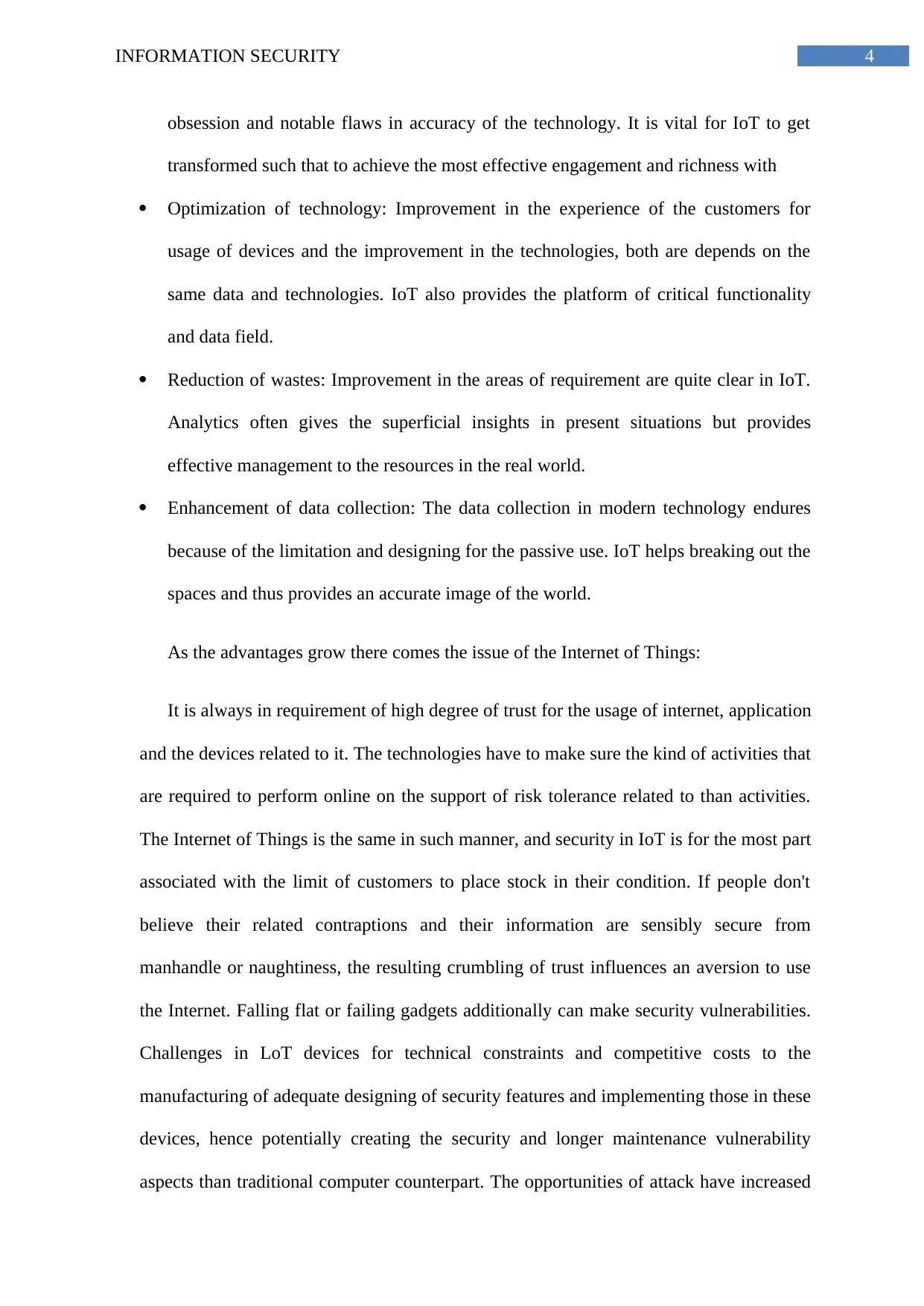
4INFORMATION SECURITY
obsession and notable flaws in accuracy of the technology. It is vital for IoT to get
transformed such that to achieve the most effective engagement and richness with
Optimization of technology: Improvement in the experience of the customers for
usage of devices and the improvement in the technologies, both are depends on the
same data and technologies. IoT also provides the platform of critical functionality
and data field.
Reduction of wastes: Improvement in the areas of requirement are quite clear in IoT.
Analytics often gives the superficial insights in present situations but provides
effective management to the resources in the real world.
Enhancement of data collection: The data collection in modern technology endures
because of the limitation and designing for the passive use. IoT helps breaking out the
spaces and thus provides an accurate image of the world.
As the advantages grow there comes the issue of the Internet of Things:
It is always in requirement of high degree of trust for the usage of internet, application
and the devices related to it. The technologies have to make sure the kind of activities that
are required to perform online on the support of risk tolerance related to than activities.
The Internet of Things is the same in such manner, and security in IoT is for the most part
associated with the limit of customers to place stock in their condition. If people don't
believe their related contraptions and their information are sensibly secure from
manhandle or naughtiness, the resulting crumbling of trust influences an aversion to use
the Internet. Falling flat or failing gadgets additionally can make security vulnerabilities.
Challenges in LoT devices for technical constraints and competitive costs to the
manufacturing of adequate designing of security features and implementing those in these
devices, hence potentially creating the security and longer maintenance vulnerability
aspects than traditional computer counterpart. The opportunities of attack have increased
obsession and notable flaws in accuracy of the technology. It is vital for IoT to get
transformed such that to achieve the most effective engagement and richness with
Optimization of technology: Improvement in the experience of the customers for
usage of devices and the improvement in the technologies, both are depends on the
same data and technologies. IoT also provides the platform of critical functionality
and data field.
Reduction of wastes: Improvement in the areas of requirement are quite clear in IoT.
Analytics often gives the superficial insights in present situations but provides
effective management to the resources in the real world.
Enhancement of data collection: The data collection in modern technology endures
because of the limitation and designing for the passive use. IoT helps breaking out the
spaces and thus provides an accurate image of the world.
As the advantages grow there comes the issue of the Internet of Things:
It is always in requirement of high degree of trust for the usage of internet, application
and the devices related to it. The technologies have to make sure the kind of activities that
are required to perform online on the support of risk tolerance related to than activities.
The Internet of Things is the same in such manner, and security in IoT is for the most part
associated with the limit of customers to place stock in their condition. If people don't
believe their related contraptions and their information are sensibly secure from
manhandle or naughtiness, the resulting crumbling of trust influences an aversion to use
the Internet. Falling flat or failing gadgets additionally can make security vulnerabilities.
Challenges in LoT devices for technical constraints and competitive costs to the
manufacturing of adequate designing of security features and implementing those in these
devices, hence potentially creating the security and longer maintenance vulnerability
aspects than traditional computer counterpart. The opportunities of attack have increased
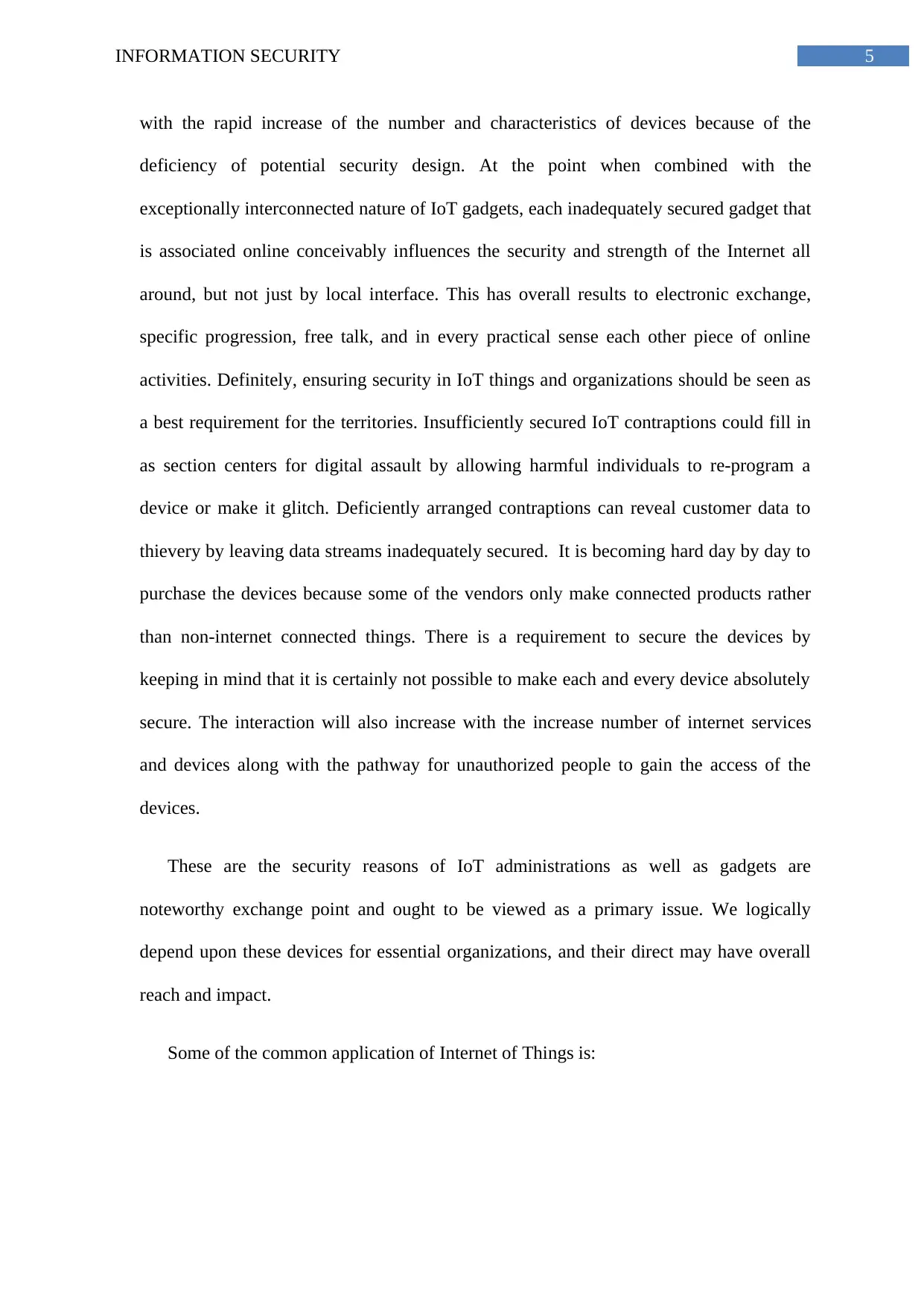
5INFORMATION SECURITY
with the rapid increase of the number and characteristics of devices because of the
deficiency of potential security design. At the point when combined with the
exceptionally interconnected nature of IoT gadgets, each inadequately secured gadget that
is associated online conceivably influences the security and strength of the Internet all
around, but not just by local interface. This has overall results to electronic exchange,
specific progression, free talk, and in every practical sense each other piece of online
activities. Definitely, ensuring security in IoT things and organizations should be seen as
a best requirement for the territories. Insufficiently secured IoT contraptions could fill in
as section centers for digital assault by allowing harmful individuals to re-program a
device or make it glitch. Deficiently arranged contraptions can reveal customer data to
thievery by leaving data streams inadequately secured. It is becoming hard day by day to
purchase the devices because some of the vendors only make connected products rather
than non-internet connected things. There is a requirement to secure the devices by
keeping in mind that it is certainly not possible to make each and every device absolutely
secure. The interaction will also increase with the increase number of internet services
and devices along with the pathway for unauthorized people to gain the access of the
devices.
These are the security reasons of IoT administrations as well as gadgets are
noteworthy exchange point and ought to be viewed as a primary issue. We logically
depend upon these devices for essential organizations, and their direct may have overall
reach and impact.
Some of the common application of Internet of Things is:
with the rapid increase of the number and characteristics of devices because of the
deficiency of potential security design. At the point when combined with the
exceptionally interconnected nature of IoT gadgets, each inadequately secured gadget that
is associated online conceivably influences the security and strength of the Internet all
around, but not just by local interface. This has overall results to electronic exchange,
specific progression, free talk, and in every practical sense each other piece of online
activities. Definitely, ensuring security in IoT things and organizations should be seen as
a best requirement for the territories. Insufficiently secured IoT contraptions could fill in
as section centers for digital assault by allowing harmful individuals to re-program a
device or make it glitch. Deficiently arranged contraptions can reveal customer data to
thievery by leaving data streams inadequately secured. It is becoming hard day by day to
purchase the devices because some of the vendors only make connected products rather
than non-internet connected things. There is a requirement to secure the devices by
keeping in mind that it is certainly not possible to make each and every device absolutely
secure. The interaction will also increase with the increase number of internet services
and devices along with the pathway for unauthorized people to gain the access of the
devices.
These are the security reasons of IoT administrations as well as gadgets are
noteworthy exchange point and ought to be viewed as a primary issue. We logically
depend upon these devices for essential organizations, and their direct may have overall
reach and impact.
Some of the common application of Internet of Things is:
⊘ This is a preview!⊘
Do you want full access?
Subscribe today to unlock all pages.

Trusted by 1+ million students worldwide
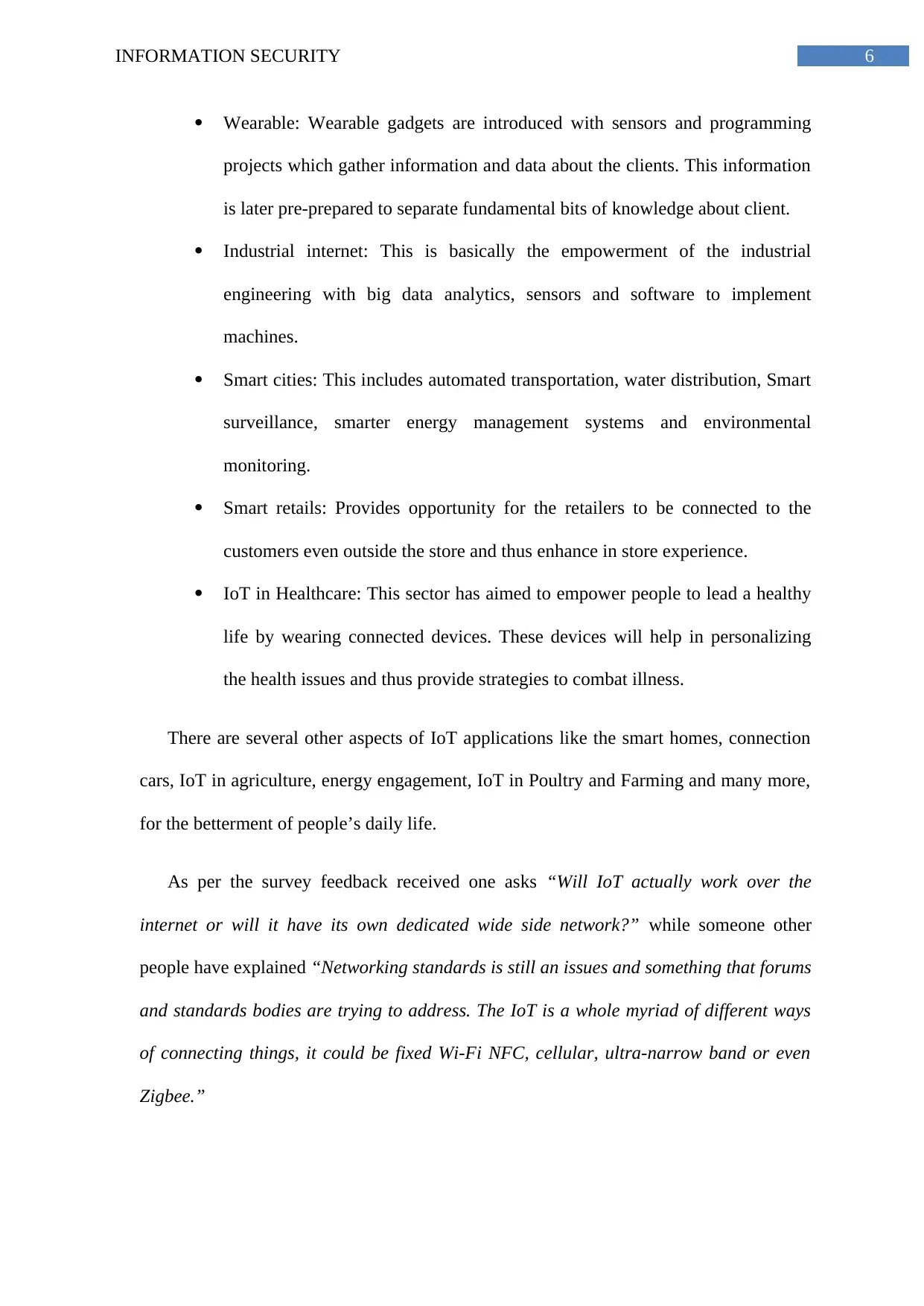
6INFORMATION SECURITY
Wearable: Wearable gadgets are introduced with sensors and programming
projects which gather information and data about the clients. This information
is later pre-prepared to separate fundamental bits of knowledge about client.
Industrial internet: This is basically the empowerment of the industrial
engineering with big data analytics, sensors and software to implement
machines.
Smart cities: This includes automated transportation, water distribution, Smart
surveillance, smarter energy management systems and environmental
monitoring.
Smart retails: Provides opportunity for the retailers to be connected to the
customers even outside the store and thus enhance in store experience.
IoT in Healthcare: This sector has aimed to empower people to lead a healthy
life by wearing connected devices. These devices will help in personalizing
the health issues and thus provide strategies to combat illness.
There are several other aspects of IoT applications like the smart homes, connection
cars, IoT in agriculture, energy engagement, IoT in Poultry and Farming and many more,
for the betterment of people’s daily life.
As per the survey feedback received one asks “Will IoT actually work over the
internet or will it have its own dedicated wide side network?” while someone other
people have explained “Networking standards is still an issues and something that forums
and standards bodies are trying to address. The IoT is a whole myriad of different ways
of connecting things, it could be fixed Wi-Fi NFC, cellular, ultra-narrow band or even
Zigbee.”
Wearable: Wearable gadgets are introduced with sensors and programming
projects which gather information and data about the clients. This information
is later pre-prepared to separate fundamental bits of knowledge about client.
Industrial internet: This is basically the empowerment of the industrial
engineering with big data analytics, sensors and software to implement
machines.
Smart cities: This includes automated transportation, water distribution, Smart
surveillance, smarter energy management systems and environmental
monitoring.
Smart retails: Provides opportunity for the retailers to be connected to the
customers even outside the store and thus enhance in store experience.
IoT in Healthcare: This sector has aimed to empower people to lead a healthy
life by wearing connected devices. These devices will help in personalizing
the health issues and thus provide strategies to combat illness.
There are several other aspects of IoT applications like the smart homes, connection
cars, IoT in agriculture, energy engagement, IoT in Poultry and Farming and many more,
for the betterment of people’s daily life.
As per the survey feedback received one asks “Will IoT actually work over the
internet or will it have its own dedicated wide side network?” while someone other
people have explained “Networking standards is still an issues and something that forums
and standards bodies are trying to address. The IoT is a whole myriad of different ways
of connecting things, it could be fixed Wi-Fi NFC, cellular, ultra-narrow band or even
Zigbee.”
Paraphrase This Document
Need a fresh take? Get an instant paraphrase of this document with our AI Paraphraser
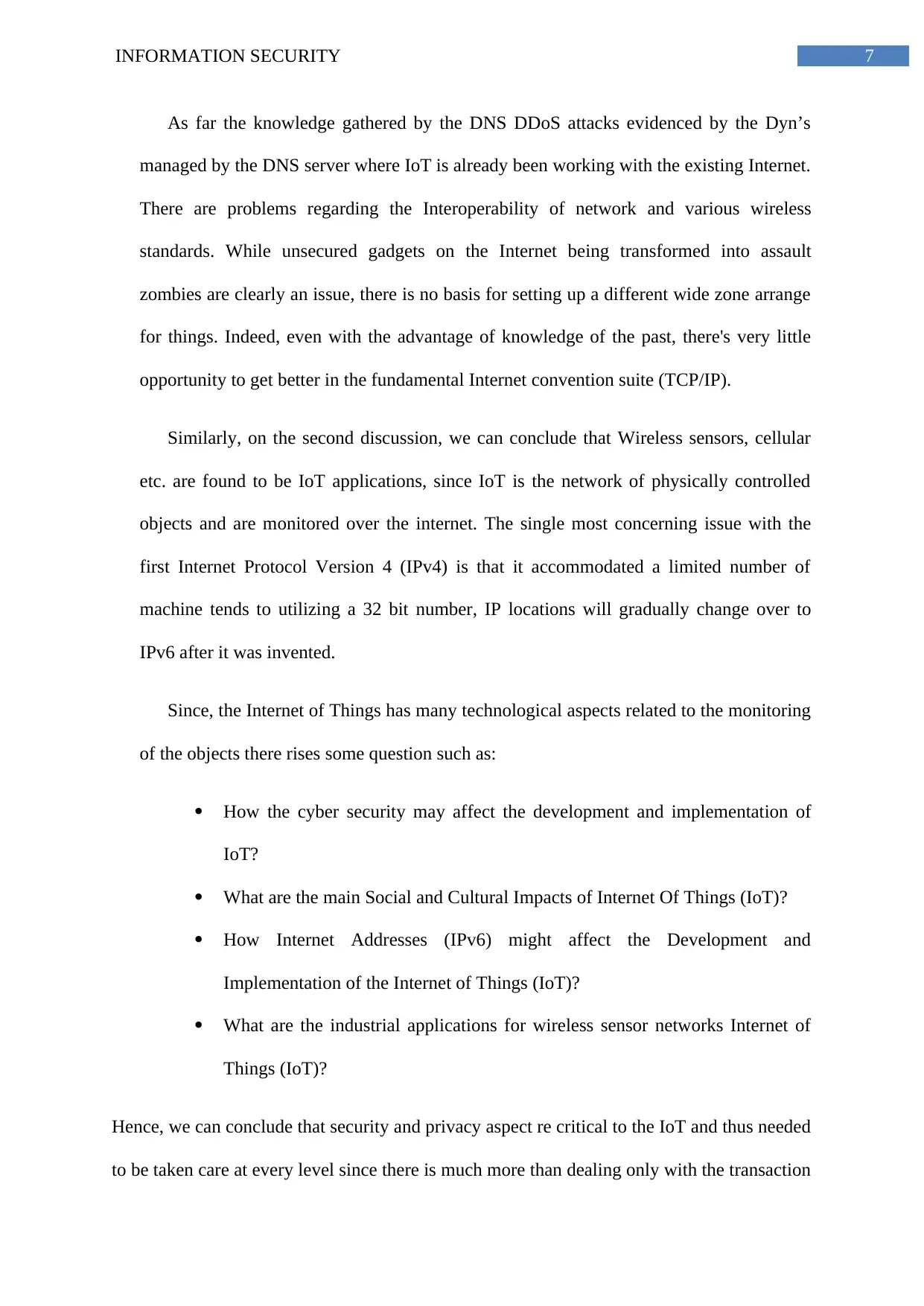
7INFORMATION SECURITY
As far the knowledge gathered by the DNS DDoS attacks evidenced by the Dyn’s
managed by the DNS server where IoT is already been working with the existing Internet.
There are problems regarding the Interoperability of network and various wireless
standards. While unsecured gadgets on the Internet being transformed into assault
zombies are clearly an issue, there is no basis for setting up a different wide zone arrange
for things. Indeed, even with the advantage of knowledge of the past, there's very little
opportunity to get better in the fundamental Internet convention suite (TCP/IP).
Similarly, on the second discussion, we can conclude that Wireless sensors, cellular
etc. are found to be IoT applications, since IoT is the network of physically controlled
objects and are monitored over the internet. The single most concerning issue with the
first Internet Protocol Version 4 (IPv4) is that it accommodated a limited number of
machine tends to utilizing a 32 bit number, IP locations will gradually change over to
IPv6 after it was invented.
Since, the Internet of Things has many technological aspects related to the monitoring
of the objects there rises some question such as:
How the cyber security may affect the development and implementation of
IoT?
What are the main Social and Cultural Impacts of Internet Of Things (IoT)?
How Internet Addresses (IPv6) might affect the Development and
Implementation of the Internet of Things (IoT)?
What are the industrial applications for wireless sensor networks Internet of
Things (IoT)?
Hence, we can conclude that security and privacy aspect re critical to the IoT and thus needed
to be taken care at every level since there is much more than dealing only with the transaction
As far the knowledge gathered by the DNS DDoS attacks evidenced by the Dyn’s
managed by the DNS server where IoT is already been working with the existing Internet.
There are problems regarding the Interoperability of network and various wireless
standards. While unsecured gadgets on the Internet being transformed into assault
zombies are clearly an issue, there is no basis for setting up a different wide zone arrange
for things. Indeed, even with the advantage of knowledge of the past, there's very little
opportunity to get better in the fundamental Internet convention suite (TCP/IP).
Similarly, on the second discussion, we can conclude that Wireless sensors, cellular
etc. are found to be IoT applications, since IoT is the network of physically controlled
objects and are monitored over the internet. The single most concerning issue with the
first Internet Protocol Version 4 (IPv4) is that it accommodated a limited number of
machine tends to utilizing a 32 bit number, IP locations will gradually change over to
IPv6 after it was invented.
Since, the Internet of Things has many technological aspects related to the monitoring
of the objects there rises some question such as:
How the cyber security may affect the development and implementation of
IoT?
What are the main Social and Cultural Impacts of Internet Of Things (IoT)?
How Internet Addresses (IPv6) might affect the Development and
Implementation of the Internet of Things (IoT)?
What are the industrial applications for wireless sensor networks Internet of
Things (IoT)?
Hence, we can conclude that security and privacy aspect re critical to the IoT and thus needed
to be taken care at every level since there is much more than dealing only with the transaction
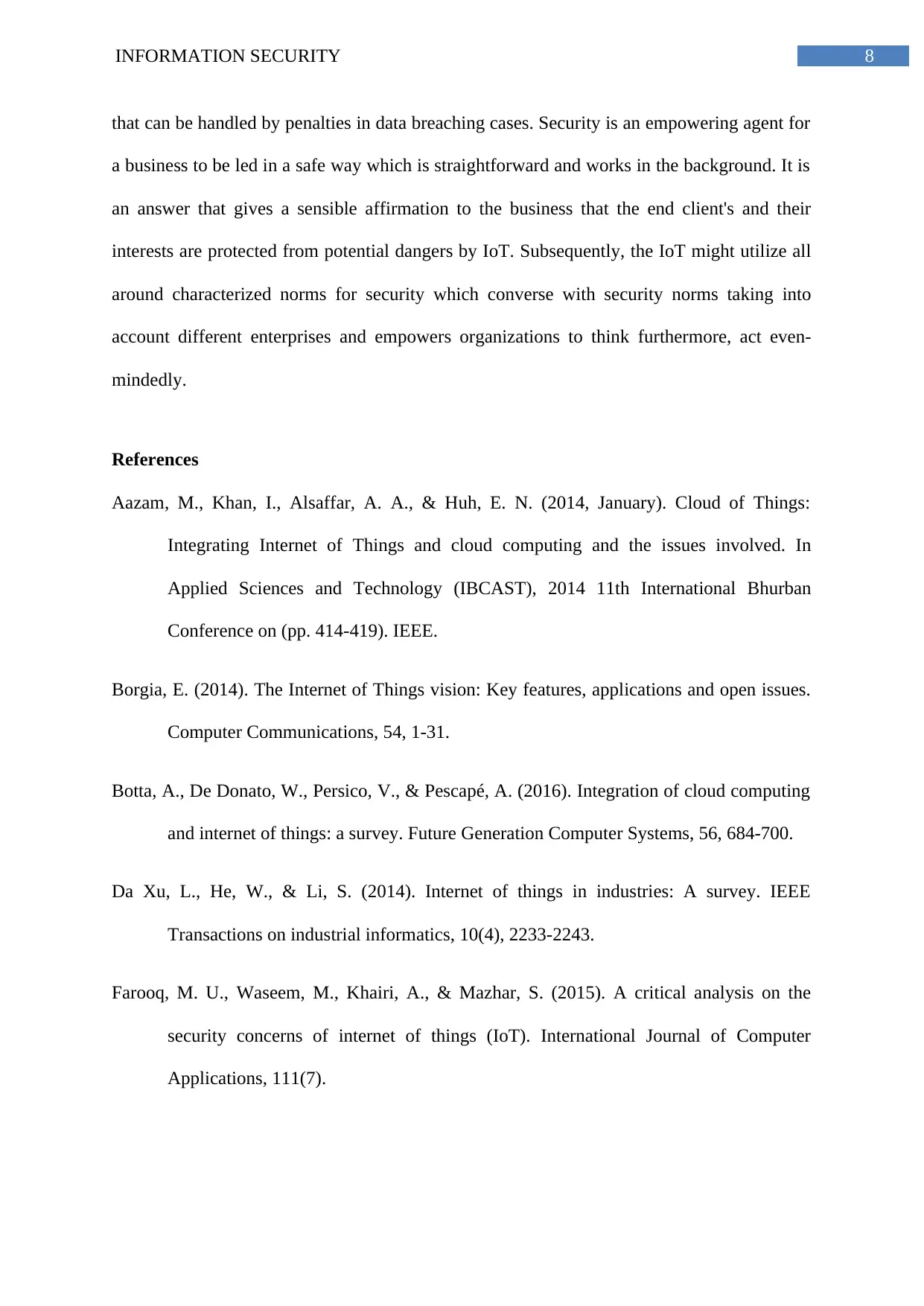
8INFORMATION SECURITY
that can be handled by penalties in data breaching cases. Security is an empowering agent for
a business to be led in a safe way which is straightforward and works in the background. It is
an answer that gives a sensible affirmation to the business that the end client's and their
interests are protected from potential dangers by IoT. Subsequently, the IoT might utilize all
around characterized norms for security which converse with security norms taking into
account different enterprises and empowers organizations to think furthermore, act even-
mindedly.
References
Aazam, M., Khan, I., Alsaffar, A. A., & Huh, E. N. (2014, January). Cloud of Things:
Integrating Internet of Things and cloud computing and the issues involved. In
Applied Sciences and Technology (IBCAST), 2014 11th International Bhurban
Conference on (pp. 414-419). IEEE.
Borgia, E. (2014). The Internet of Things vision: Key features, applications and open issues.
Computer Communications, 54, 1-31.
Botta, A., De Donato, W., Persico, V., & Pescapé, A. (2016). Integration of cloud computing
and internet of things: a survey. Future Generation Computer Systems, 56, 684-700.
Da Xu, L., He, W., & Li, S. (2014). Internet of things in industries: A survey. IEEE
Transactions on industrial informatics, 10(4), 2233-2243.
Farooq, M. U., Waseem, M., Khairi, A., & Mazhar, S. (2015). A critical analysis on the
security concerns of internet of things (IoT). International Journal of Computer
Applications, 111(7).
that can be handled by penalties in data breaching cases. Security is an empowering agent for
a business to be led in a safe way which is straightforward and works in the background. It is
an answer that gives a sensible affirmation to the business that the end client's and their
interests are protected from potential dangers by IoT. Subsequently, the IoT might utilize all
around characterized norms for security which converse with security norms taking into
account different enterprises and empowers organizations to think furthermore, act even-
mindedly.
References
Aazam, M., Khan, I., Alsaffar, A. A., & Huh, E. N. (2014, January). Cloud of Things:
Integrating Internet of Things and cloud computing and the issues involved. In
Applied Sciences and Technology (IBCAST), 2014 11th International Bhurban
Conference on (pp. 414-419). IEEE.
Borgia, E. (2014). The Internet of Things vision: Key features, applications and open issues.
Computer Communications, 54, 1-31.
Botta, A., De Donato, W., Persico, V., & Pescapé, A. (2016). Integration of cloud computing
and internet of things: a survey. Future Generation Computer Systems, 56, 684-700.
Da Xu, L., He, W., & Li, S. (2014). Internet of things in industries: A survey. IEEE
Transactions on industrial informatics, 10(4), 2233-2243.
Farooq, M. U., Waseem, M., Khairi, A., & Mazhar, S. (2015). A critical analysis on the
security concerns of internet of things (IoT). International Journal of Computer
Applications, 111(7).
⊘ This is a preview!⊘
Do you want full access?
Subscribe today to unlock all pages.

Trusted by 1+ million students worldwide
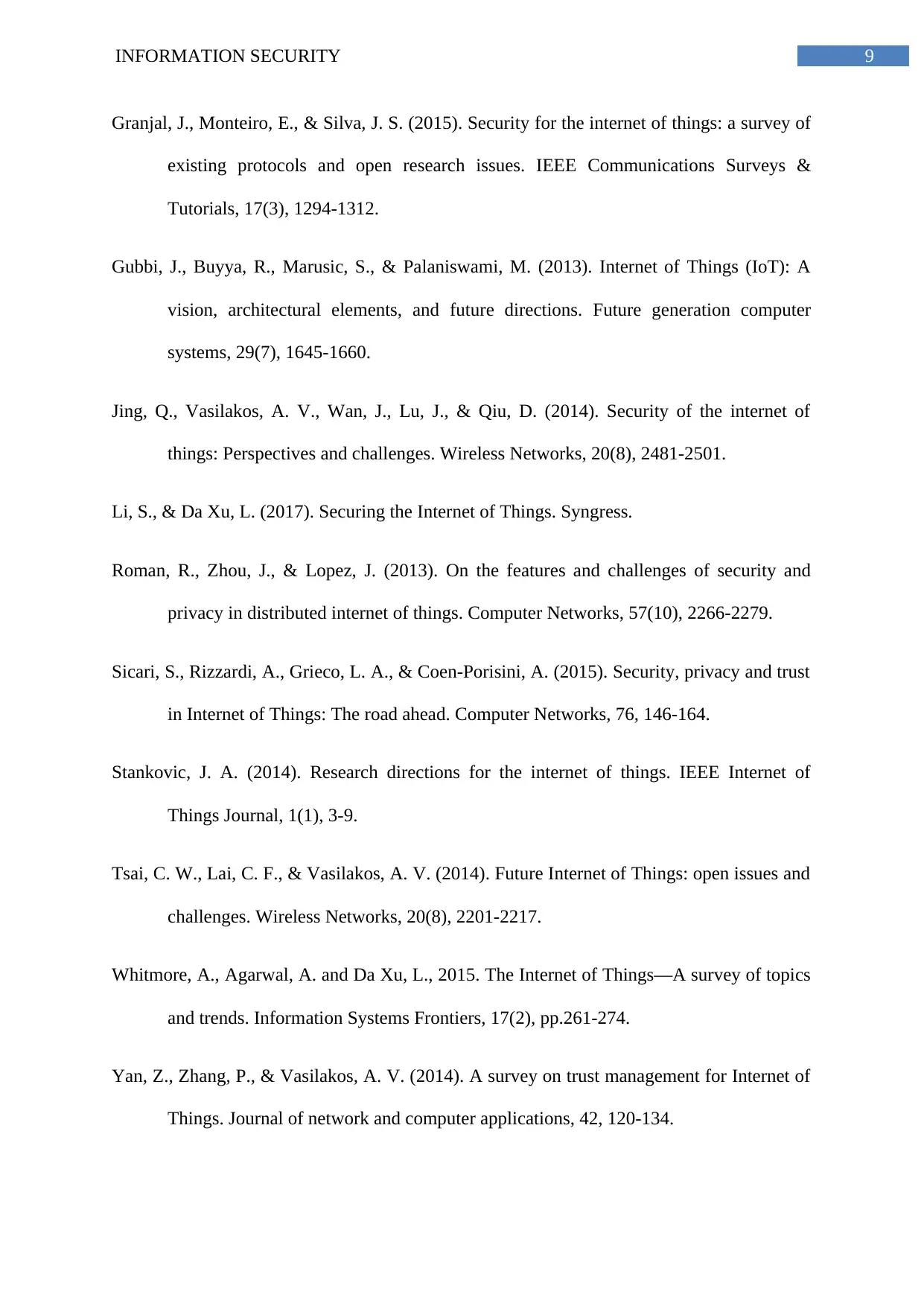
9INFORMATION SECURITY
Granjal, J., Monteiro, E., & Silva, J. S. (2015). Security for the internet of things: a survey of
existing protocols and open research issues. IEEE Communications Surveys &
Tutorials, 17(3), 1294-1312.
Gubbi, J., Buyya, R., Marusic, S., & Palaniswami, M. (2013). Internet of Things (IoT): A
vision, architectural elements, and future directions. Future generation computer
systems, 29(7), 1645-1660.
Jing, Q., Vasilakos, A. V., Wan, J., Lu, J., & Qiu, D. (2014). Security of the internet of
things: Perspectives and challenges. Wireless Networks, 20(8), 2481-2501.
Li, S., & Da Xu, L. (2017). Securing the Internet of Things. Syngress.
Roman, R., Zhou, J., & Lopez, J. (2013). On the features and challenges of security and
privacy in distributed internet of things. Computer Networks, 57(10), 2266-2279.
Sicari, S., Rizzardi, A., Grieco, L. A., & Coen-Porisini, A. (2015). Security, privacy and trust
in Internet of Things: The road ahead. Computer Networks, 76, 146-164.
Stankovic, J. A. (2014). Research directions for the internet of things. IEEE Internet of
Things Journal, 1(1), 3-9.
Tsai, C. W., Lai, C. F., & Vasilakos, A. V. (2014). Future Internet of Things: open issues and
challenges. Wireless Networks, 20(8), 2201-2217.
Whitmore, A., Agarwal, A. and Da Xu, L., 2015. The Internet of Things—A survey of topics
and trends. Information Systems Frontiers, 17(2), pp.261-274.
Yan, Z., Zhang, P., & Vasilakos, A. V. (2014). A survey on trust management for Internet of
Things. Journal of network and computer applications, 42, 120-134.
Granjal, J., Monteiro, E., & Silva, J. S. (2015). Security for the internet of things: a survey of
existing protocols and open research issues. IEEE Communications Surveys &
Tutorials, 17(3), 1294-1312.
Gubbi, J., Buyya, R., Marusic, S., & Palaniswami, M. (2013). Internet of Things (IoT): A
vision, architectural elements, and future directions. Future generation computer
systems, 29(7), 1645-1660.
Jing, Q., Vasilakos, A. V., Wan, J., Lu, J., & Qiu, D. (2014). Security of the internet of
things: Perspectives and challenges. Wireless Networks, 20(8), 2481-2501.
Li, S., & Da Xu, L. (2017). Securing the Internet of Things. Syngress.
Roman, R., Zhou, J., & Lopez, J. (2013). On the features and challenges of security and
privacy in distributed internet of things. Computer Networks, 57(10), 2266-2279.
Sicari, S., Rizzardi, A., Grieco, L. A., & Coen-Porisini, A. (2015). Security, privacy and trust
in Internet of Things: The road ahead. Computer Networks, 76, 146-164.
Stankovic, J. A. (2014). Research directions for the internet of things. IEEE Internet of
Things Journal, 1(1), 3-9.
Tsai, C. W., Lai, C. F., & Vasilakos, A. V. (2014). Future Internet of Things: open issues and
challenges. Wireless Networks, 20(8), 2201-2217.
Whitmore, A., Agarwal, A. and Da Xu, L., 2015. The Internet of Things—A survey of topics
and trends. Information Systems Frontiers, 17(2), pp.261-274.
Yan, Z., Zhang, P., & Vasilakos, A. V. (2014). A survey on trust management for Internet of
Things. Journal of network and computer applications, 42, 120-134.
Paraphrase This Document
Need a fresh take? Get an instant paraphrase of this document with our AI Paraphraser
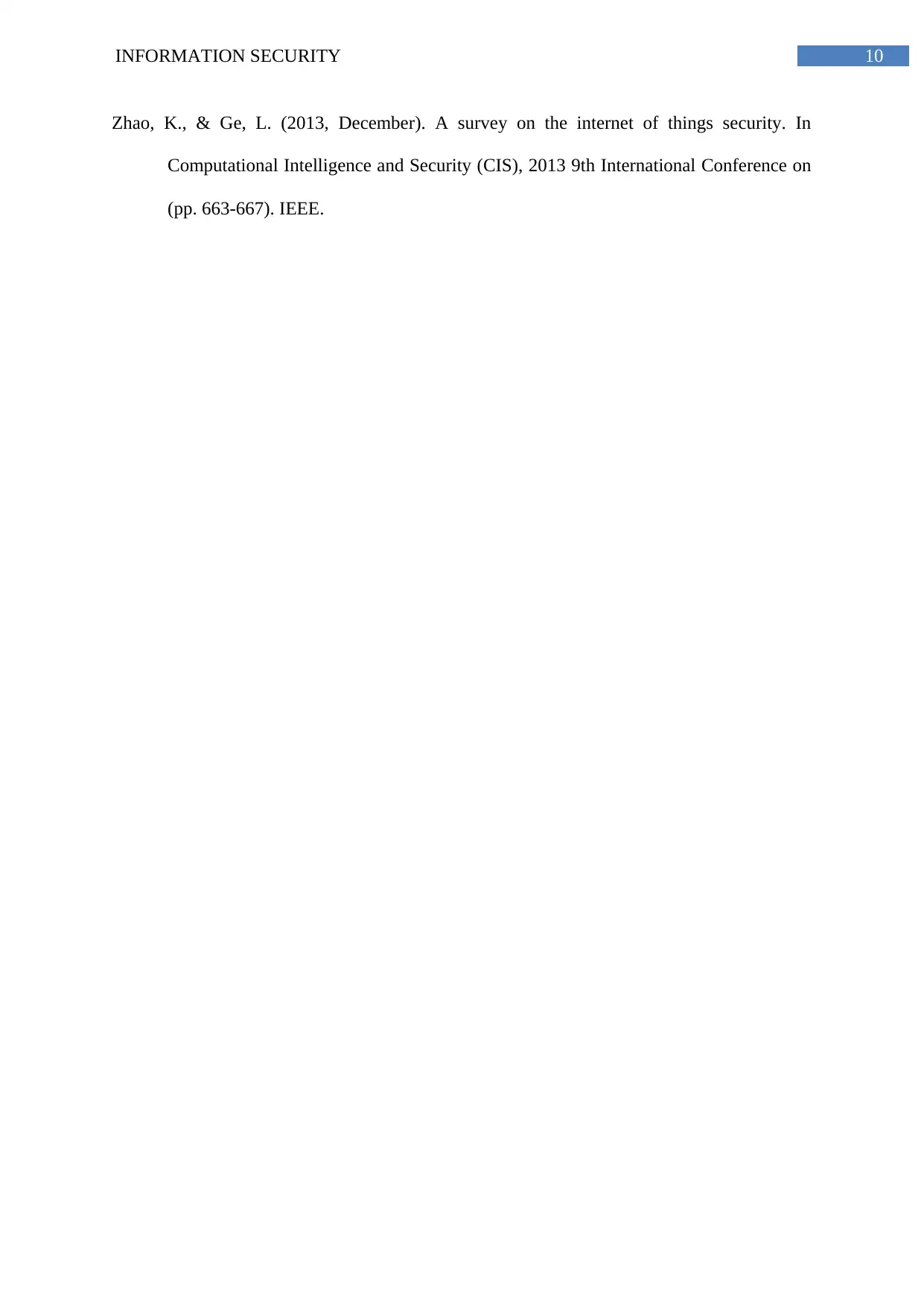
10INFORMATION SECURITY
Zhao, K., & Ge, L. (2013, December). A survey on the internet of things security. In
Computational Intelligence and Security (CIS), 2013 9th International Conference on
(pp. 663-667). IEEE.
Zhao, K., & Ge, L. (2013, December). A survey on the internet of things security. In
Computational Intelligence and Security (CIS), 2013 9th International Conference on
(pp. 663-667). IEEE.
1 out of 11
Related Documents
Your All-in-One AI-Powered Toolkit for Academic Success.
+13062052269
info@desklib.com
Available 24*7 on WhatsApp / Email
![[object Object]](/_next/static/media/star-bottom.7253800d.svg)
Unlock your academic potential
Copyright © 2020–2025 A2Z Services. All Rights Reserved. Developed and managed by ZUCOL.





